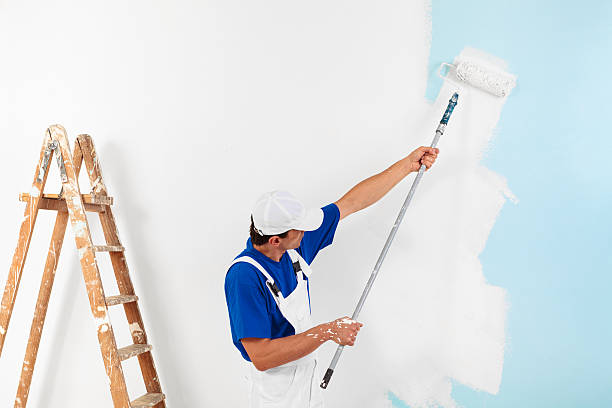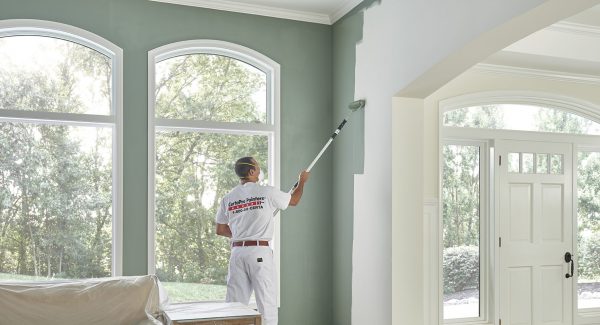Remain Ahead With New Paint Trends: Blending Strategies for Modern Interiors

The Surge of Color Gradients in Interior Decoration
As designers significantly seek ingenious methods to boost spaces, the rise of color slopes in interior design has actually gathered substantial attention. This method, identified by the smooth shift between two or more shades, enables a vibrant visual effect that can transform a common area into a lively setting. Shade gradients can stimulate feelings, affect understandings of room, and develop focal points, making them a versatile option for different style styles.
The application of slopes expands past walls; they can be properly employed in furnishings, fabrics, and devices. Developers commonly experiment with varying shades to accomplish deepness and intrigue, appealing to a variety of visual appeals from minimal to diverse. On top of that, the adaptability of gradients enables their use in both domestic and business settings, satisfying diverse customers. As patterns progress, the use of shade slopes represents a shift towards even more personalized and expressive indoor rooms, mirroring private preferences and way of lives.
Accepting Ombre Techniques for a Dynamic Look
Ombre methods have actually become an enchanting selection for those wanting to add deepness and activity to modern insides. This gradient effect shifts efficiently from one shade to another, producing an aesthetically striking prime focus in any type of space. Designers appreciate ombre for its flexibility; it can be applied to walls, furnishings, or perhaps attractive accents, permitting special expressions of style.
The technique works specifically well with soft colors, giving a calm ambiance, while strong colors can energize a space. Homeowners can experiment with various shade combinations, choosing contrasting tones for a dramatic influence or harmonious tones for a refined effect. The application of ombre is not restricted to a single wall surface; it can extend throughout an area, improving the perception of area and light.
As a modern trend, ombre strategies accommodate varied preferences, permitting individuals to individualize their interiors and welcome imagination in their layout strategy. paint shops in corpus christi.
Distinctive Walls: Layering Paint for Depth and Rate of interest
Textured wall surfaces can significantly improve the aesthetic allure of modern interiors by adding depth and rate of interest. Methods for developing appearance, thoughtful color combinations, and the right tools for layering are crucial components in accomplishing this result. Discovering these components permits a dynamic and tailored approach to interior decoration.
Strategies for Texture Creation
Creating aesthetic interest in interior rooms frequently pivots on the artistic application of structure. Different methods can be utilized to accomplish this, such as sponging, cloth rolling, and stippling. Sponging includes making use of a wet sponge to use a second shade over a base layer, creating a soft, mottled impact. Rag rolling, on the various other hand, utilizes a rolled cloth to apply paint, leading to a more dynamic texture. Stippling uses a tight brush or tool to dab paint onto the surface area, producing an one-of-a-kind pattern. In addition, layering various finishes, such as matte and shiny, can boost depth. These techniques not just provide aesthetic allure however also contribute to the total atmosphere of modern-day insides, motivating a tactile experience.
Shade Combinations for Impact
Layering paint not just improves appearance yet likewise opens a world of shade combinations that can significantly influence the mood of an area. By mixing complementary tones, developers can produce an unified result that invites warmth or coolness, depending on the wanted ambience. For example, rich earth tones matched with soft pastels can evoke a calm environment, while vibrant, contrasting shades can add vibrancy and power. Additionally, including metallic or shiny surfaces within the layers can present a dynamic visual element, capturing light and enhancing the depth of the color design. Ultimately, thoughtful shade mixes via layering paint give a chance to express private design while transforming average wall surfaces into captivating centerpieces.
Tools for Layering Impact
Various tools are essential for achieving a successful layering result in paint applications, which can transform walls into bewitching visual experiences. Rollers and brushes are essential, with different dimensions permitting different structures and coatings. Specialty tools like cloths and sponges can develop one-of-a-kind patterns and depth, while palette blades supply accuracy for even more specified lines. For bigger locations, making use of a stippling brush can include a detailed coating. In addition, spray guns can efficiently apply several layers for a smooth, even coat. Painters must additionally take into consideration painter's tape to create clean edges between layers. By utilizing the right devices, one can efficiently improve the aesthetic appeal of interiors, making each wall a fascinating prime focus.

The Power of Color Obstructing in Modern Spaces
As contemporary interior decoration proceeds to evolve, color blocking becomes a powerful method that can change spaces with strong aesthetic impact. This technique involves the critical placement of contrasting colors to produce specified zones within a room, improving both the visual appeal and functionality of the space. paint store corpus christi tx. By utilizing huge swathes of shade, developers can direct the eye and stress building aspects, resulting in a dynamic atmosphere
Color barring is not restricted to walls; it can also be related to furnishings and more info style, permitting endless customization. As an example, matching a lively color with a neutral tone can create a striking centerpiece while maintaining equilibrium. This technique motivates creativity, enabling property owners to share their characters through distinct color mixes. Inevitably, shade obstructing functions as an efficient means to take a breath new life right into contemporary interiors, making spaces feel fresh, energised, and aesthetically appealing.
Integrating Metallics for a Glamorous Complete
How can metallics raise the class of modern interiors? Metal coatings function as a striking prime focus, including depth and visual passion to rooms. They can change a basic room right into a classy resort via the subtle interaction of light and representation. Designers often suggest integrating metallics in accent walls, ceilings, or furnishings to produce an elegant atmosphere without frustrating the area.
Different metallic shades-- such as silver, gold, and bronze-- supply versatility, enabling property owners to customize their visual. A soft gold can impart heat, while a sleek silver can provide a modern touch. When combined with neutral tones, metallics enhance the general layout, giving a sophisticated comparison that attracts the eye.
Incorporating metallic paint right into trim or moldings can likewise elevate architectural details, creating a refined finish. Ultimately, the tactical usage of metallics can infuse modern-day insides with beauty and improvement, making them genuinely bewitching.
Creative Use Stencils for Unique Patterns
Changing walls with stencils can instill modern-day interiors with distinct character and design. This creative method enables developers and property owners to create customized patterns that mirror personal appearances. Stencils can range from intricate geometric designs to wayward concepts, allowing a wide variety of expressions. By choosing contrasting shades, stencils can raise a space's visual charm and function as prime focus without overwhelming the space.
Moreover, stencils are flexible; they can be related to different surface areas, consisting of wall surfaces, furniture, and also ceilings. This versatility makes stenciling a suitable choice for do it yourself fanatics looking to boost their home cost effectively. Furthermore, the convenience of application and elimination permits experimentation, allowing individuals to rejuvenate their style with marginal initiative. Ultimately, creative usage of patterns not just changes ordinary surfaces however also offers an opportunity for self-expression, making them a trending option in contemporary interior decoration.
Blending Matte and Glossy Surfaces for Contrast
The interaction of matte and shiny surfaces can produce a striking aesthetic dynamic in modern-day interiors. Developers typically use this comparison to enhance architectural features and specify spaces. Matte surfaces, with their soft, non-reflective top quality, can produce a feeling of warmth and affection, making them optimal for walls and larger surfaces. On the other hand, glossy coatings mirror light, including vibrancy and deepness, making them ideal for accents such as trim, moldings, or furnishings.
The combination of these appearances can assist the eye and stress focal points within a room. Combining a matte-painted wall with shiny kitchen cabinetry can create a sophisticated equilibrium. Additionally, the careful application of both coatings can stimulate different moods while boosting the general visual. As house owners progressively seek tailored areas, mixing matte and shiny surfaces uses a flexible technique to achieving contemporary elegance and visual interest in interior layout.
Frequently Asked Questions
What Devices Are Best for Blending Paint Techniques?
A range of tools are excellent for mixing paint techniques, including foam rollers, brushes with soft bristles, sponge applicators, and airbrushes. Each device gives one-of-a-kind results, improving the mixing procedure for different creative applications.
Just How Can I Fix Mixing Mistakes?
To deal with blending errors, one should gently sand the damaged location, apply a primer if essential, and afterwards thoroughly reapply paint utilizing a soft brush or sponge to achieve a smooth change and bring back the desired impact.
Exist Certain Paint Brands Recommended for Blending?
Numerous paint brands are recommended for mixing, consisting of Benjamin Moore, Sherwin-Williams, and Behr. These brand names supply high-quality surfaces and a vast array of colors that facilitate smooth changes and reliable blending methods in different interior tasks.
Can I Mix Paint Without Expert Aid?
Yes, mixing paint without expert assistance is feasible. With practice and the right devices, people can attain preferable effects. Numerous online tutorials and guides can assist in mastering mixing techniques for personal tasks.

For How Long Does Blended Paint Last on Walls?
Combined paint can last anywhere from five to 10 years on wall surfaces, depending upon aspects such as the top quality of paint made use of, surface prep work, and ecological problems. Normal upkeep normally improves longevity and look.
As designers significantly seek ingenious ways to enhance spaces, the increase of shade gradients in indoor design has garnered substantial attention. The strategy functions especially well with soft hues, offering a serene atmosphere, while strong shades can energize a room. Strategies for developing structure, thoughtful color mixes, and the right devices for layering are necessary parts in achieving this impact. Layering paint not only enhances structure but also opens up a world of color mixes that can substantially influence the mood of a room. As modern indoor design continues to progress, shade blocking arises as a powerful technique that can change rooms with strong visual influence.